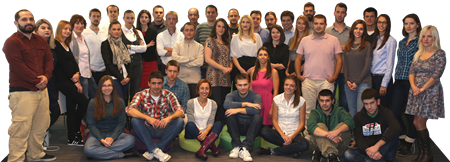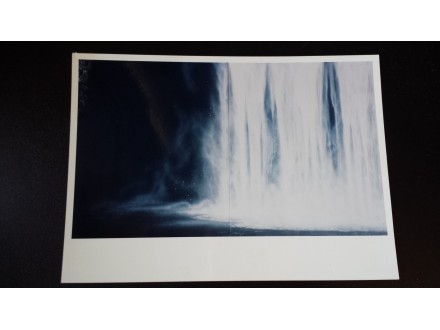Hiroshi Senju, The Falls 1995 (Bijenale u Veneciji)
| Cena: |
| Želi ovaj predmet: | 3 |
| Stanje: | Polovan bez oštećenja |
| Garancija: | Ne |
| Isporuka: | BEX Pošta Post Express Lično preuzimanje |
| Plaćanje: | Tekući račun (pre slanja) Ostalo (pre slanja) Pouzećem Lično |
| Grad: |
Novi Sad, Novi Sad |
Kulturno dobro: Predmet koji prodajem nije kulturno dobro ili ovlašćena institucija odbija pravo preče kupovine
sa Bijenala u Veneciji
Hiroshi Senju
Hiroshi Senju (千住博 Senju Hiroshi, born 1958) is a Nihonga painter known for his large scale waterfall paintings.
He completed MFA program in Fine Arts at Tokyo University of the Arts, 1984. He withdrew from the doctoral program at the Graduate School of Tokyo University of the Arts after fulfilling the credit requirements in 1987. His graduation work was purchased by The University of Tokyo.
His success largely came about in the 1990s in response to his gigantic waterfall paints.[1] These paintings often hung in corporate and public buildings, and Senju has been said to be one of a few artists today whose work is recognized by the general population.[1]
Senju’s waterfall was the first painting by an Asian artist to be awarded the Honorable Mention at the Venice Biennale in 1995.[2]
These waterfall paintings often focus at the base of the waterfall where the falls crash into the pool below, usually cropping out the top of the falls.[1] As a painter he primarily uses traditional Japanese painting techniques; employing pigments derived from natural materials and applying them to a specially designed mulberry paper.[3] In contrast to the norm of displaying such works in a dimly lit, tatami matted room, Hiroshi prefers his paintings to be viewed under natural light.[4]
Venice Biennale in 1995[edit]
In 1995, at the 46th Venice Biennale celebrating its centennial year, Senju, who represented Japan, exhibited a huge waterfall mural in Japan Pavilion, measuring 3.4 meters high and 14 meters wide. Senju titled the work “THE FALL”, which implied the fall of man, in Christian theology, God expelling Adam and Eve from the Garden.[5]
During the installation process, a welding contractor accidentally dropped scorching coal tar on his painting. Senju, watching the incident happened, immediately rushed for it and removed the coal tar by his bare hand. He had to go to emergency hospital with his left hand got burned. The only consolation was that Senju’s dominant hand was uninjured, being able to repair the damage by the opening of Biennale.[6]
Senju’s waterfall was the first painting by an Asian artist to be awarded the Honorable Mention, for having “expressed the meditative world of nature and the fluctuations of Japan’s traditional culture.”[7]
The Japan Hall commissioner was Junji Ito and the other exhibition artists were Yoichiro Kawaguchi, Zaigin Sai, and Katsuhiko Hibino. The site organizer was Kengo Kuma.[7]
Haneda Airport[edit]
From 2004 to 2011, Senju created a series of large commissioned works for Haneda Airport in Tokyo, Japan.
These works include: Water Shrine, a painting, 2.5 meters high by 17.9 meters wide, located at International Terminal in front of immigration Inspection. Ginga (Galaxy), a painting, 100 square meters, on the top ceiling of Terminal 2. Youru no Kohan (Evening Lakeside), a painting measuring 2.5 meters high and 12.5 meters wide, located at Terminal 2, 1F Terminal lobby. Moon, a sitting sculpture of bull, located at Terminal 2, 5F Market place. Asa no Kohan (Morning Lakeside), a painting, 2.5 meters high and 14 meters wide, located at Terminal 2, 1F Terminal lobby.[8][9]
Shofuso[edit]
In 2007, Hiroshi Senju created a series of 20 fusuma (paper sliding door) paintings for the Shofuso Japanese House and Garden,[10] in Philadelphia, PA. Asked to replace the destroyed fusuma paintings of Japanese National Treasure, artist Higashiyama Kaii, Senju said, `Shofuso offers a wonderful space for murals far exceeding my expectations, and I will do my best to paint murals symbolizing and important symbolic exchange between Japan and the United States.`[10]
Senju completed the installation in July 2006.[10] He named the largest murals (8`x 12 1/2`), which serve as the centerpiece in the tokonoma alcove, Water Curtain, a play on the classic symbol of the Cold War, the Iron Curtain.[10] This curtain, with its layers of falling water, was meant to symbolize the freedom of Philadelphia, the birthplace of the United States.[10] The six murals in the first room are named Imagination of Dynamics and those of the second room are titled Imagination of Silence.[10]
The murals were first exhibited at Gwangju Biennale in South Korea in 2006 and were subsequently exhibited at the Yamatane Museum in Tokyo, Japan.[10] More than fifty thousand visitors saw the murals prior to their installation at Shofuso.[10] The murals were then shipped to their final destination in Philadelphia, arriving in March and installed in April 2007.[10]
In donating the new murals, Senju honored Shōfusō in the ancient Japanese tradition of master painters offering their talents to the community.[10] Shofuso is the only place outside Japan to house a unique combination of contemporary art and traditional Japanese architecture.[10]
He also participated in the Art House Project in Naoshima, Kagawa[11]
Venice Biennale in 2015[edit]
In 2015, Senju exhibited large-scale fluorescent pigment waterfalls Ryujin I and Ryujin II in a pitch-dark space, and natural pigment waterfall Suijin under daylight at Frontiers Reimagined, a collateral event of the Venice Biennale curated and organized by Sundaram Tagore Foundation.[3]
Kongōbu-ji[edit]
In 2015, It was officially confirmed that Senju would create a series of fusuma paintings for the head temple of Kongōbu-ji of Koyasan, located on Mount Kōya, Wakayama, Japan.
Books[edit]
Hiroshi Senju. SKIRA. 2009. ISBN 978-88-6130797-1.
Museum[edit]
Hiroshi Senju Museum Karuizawa[12] opened 10 October 2011 in Karuizawa, Nagano Prefecture.[4] The museum was designed by architect Ryue Nishizawa, and consists of windows which make up the walls, a gently sloping concrete floor which naturally contours to the ground, and thin concrete walls scattered throughout the center of the museum which support the ceiling.[4] The museum is owned and operated by the International Cultural College Foundation which possesses around 100 works by Hiroshi, about half of which can be displayed in the museum at any given time.[4]
bijenale venecija
International shipping
Paypal only
(Države Balkana: Uplata može i preko pošte ili Western Union-a)
1 euro = 117.5 din
For international buyers please see instructions below:
To buy an item: Click on the red button KUPI ODMAH
Količina: 1 / Isporuka: Pošta / Plaćanje: Tekući račun
To confirm the purchase click on the orange button: Potvrdi kupovinu (After that we will send our paypal details)
To message us for more information: Click on the blue button POŠALJI PORUKU
To see overview of all our items: Click on Svi predmeti člana
Ako je aktivirana opcija besplatna dostava, ona se odnosi samo na slanje kao preporučena tiskovina ili cc paket na teritoriji Srbije.
Poštarina za knjige je u proseku 133-200 dinara, u slučaju da izaberete opciju plaćanje pre slanja i slanje preko pošte. Postexpress i kurirske službe su skuplje ali imaju opciju plaćanja pouzećem. Ako nije stavljena opcija da je moguće slanje i nekom drugom kurirskom službom pored postexpressa, slobodno kupite knjigu pa nam u poruci napišite koja kurirska služba vam odgovara.
Ukoliko još uvek nemate bar 10 pozitivnih ocena, zbog nekoliko neprijatnih iskustava, molili bi vas da nam uplatite cenu kupljenog predmeta unapred.
Novi Sad lično preuzimanje ili svaki dan ili jednom nedeljno zavisno od lokacije prodatog predmeta.
Našu kompletnu ponudu možete videti preko linka
https://www.kupindo.com/Clan/H.C.E/SpisakPredmeta
Ukoliko tražite još neki naslov koji ne možete da nađete pošaljite nam poruku možda ga imamo u magacinu.
Pogledajte i našu ponudu na limundu https://www.limundo.com/Clan/H.C.E/SpisakAukcija
Slobodno pitajte šta vas zanima preko poruka. Preuzimanje moguce u Novom Sadu i Sremskoj Mitrovici uz prethodni dogovor. (Većina knjiga je u Sremskoj Mitrovici, manji broj u Novom Sadu, tako da se najavite nekoliko dana ranije u slucaju ličnog preuzimanja, da bi knjige bile donete, a ako Vam hitno treba neka knjiga za danas ili sutra, obavezno proverite prvo preko poruke da li je u magacinu da ne bi doslo do neprijatnosti). U krajnjem slučaju mogu biti poslate i poštom u Novi Sad i stižu za jedan dan.
U Novom Sadu lično preuzimanje na Grbavici na našoj adresi ili u okolini po dogovoru. Dostava na kućnu adresu u Novom Sadu putem kurira 350 dinara.
Slanje nakon uplate na račun u Erste banci (ukoliko ne želite da plaćate po preuzimanju). Poštarina za jednu knjigu, zavisno od njene težine (do 2 kg), može biti od 170-264 din. Slanje vise knjiga u paketu težem od 2 kg 340-450 din. Za cene postexpressa ili drugih službi se možete informisati na njihovim sajtovima.
http://www.postexpress.rs/struktura/lat/cenovnik/cenovnik-unutrasnji-saobracaj.asp
INOSTRANSTVO: Šaljem po dogovoru, ili po vašim prijateljima/rodbini ili poštom. U Beč idem jednom godišnje pa ako se podudare termini knjige mogu doneti lično. Skuplje pakete mogu poslati i po nekom autobusu, molim vas ne tražite mi da šaljem autobusima knjige manje vrednosti jer mi odlazak na autobusku stanicu i čekanje prevoza pravi veći problem nego što bi koštala poštarina za slanje kao mali paket preko pošte.
Ukoliko kupujete više od jedne knjige javite se porukom možda Vam mogu dati određeni popust na neke naslove.
Sve knjige su detaljno uslikane, ako Vas još nešto interesuje slobodno pitajte porukom. Reklamacije primamo samo ukoliko nam prvo pošaljete knjigu nazad da vidim u čemu je problem pa nakon toga vraćamo novac. Jednom smo prevareni od strane člana koji nam je vratio potpuno drugu knjigu od one koju smo mu mi poslali, tako da više ne vraćamo novac pre nego što vidimo da li se radi o našoj knjizi.
Ukoliko Vam neka pošiljka ne stigne za dva ili tri dana, odmah nas kontaktirajte za broj pošiljke kako bi videli u čemu je problem. Ne čekajte da prođe više vremena, pogotovo ako ste iz inostranstva, jer nakon određenog vremena pošiljke se vraćaju pošiljaocu, tako da bi morali da platimo troškove povratka i ponovnog slanja. Potvrde o slanju čuvamo do 10 dana. U 99% slučajeva sve prolazi glatko, ali nikad se ne zna.
Ukoliko uvažimo vašu reklamaciju ne snosimo troškove poštarine, osim kada je očigledno naša greška u pitanju.
Predmet: 42309085









